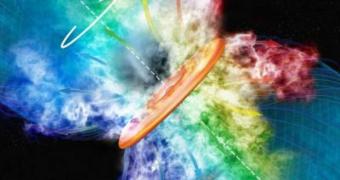Massive stars are giants several hundred times the mass of our Sun, which have the ability to form neutron stars and black holes at the end of their burning cycle. They are a rare occurrence in the Universe, so the processes involved in their birth sequences have been very little understood until now. With the help of a powerful radio telescope, scientists have now been able to peer through the massive clouds of gas and dust that usually surround new, massive stars, and get a glimpse of how they develop in the giants of the skies.
For the new investigation, the US National Science Foundation's (NSF) Very Long Baseline Array (VLBA) telescope was used. The radio observatory has the longest baseline in the world, spanning more than 8,611 kilometers, or roughly 5,351 miles. It consists of ten 82-foot (25-meter) antennas, located at designated sites in Hawaii, Washington, California, New Mexico, the Virgin Islands and other states. This spread gives astronomers the ability to use the telescope as a “zoom lens.” Given the fact that it works in radio wavelengths, the observatory is also able to penetrate the massive clouds surrounding massive star-formation areas, and to make out what goes on “behind the curtains.”
“We know how these stars die, but not how they are born,” Lincoln Greenhill says. He is the principal investigator for the new study, and also a member of the team that made the recent observations. The group also includes scientists from the Harvard-Smithsonian Center for Astrophysics (CfA), and the National Radio Astronomy Observatory (NRAO). The main target of the research was the Great Nebula, an area of intense stellar formation, located in the “Sword” region of the Orion constellation. For two years, the VLBA captured pictures of a maser-generating region called Source I (pronounced “eye”), at one-month intervals.
Scientists then stitched the photos together, and obtained a time-lapse video of what went on inside the formation. Masers are laser-like, silicon monoxide gas clouds, which are believed to be a clear indicator of stellar formation. “Source I is the richest source of masers in the Galaxy, that we know of. Without the masers, we couldn't track the gas motions in such detail so close to this massive star, and would be relatively blind to its formation,” MIT Haystack Observatory researcher Lynn Matthews adds. She has also been the lead author of the research.
“In astronomy, it's rare to see changes over the course of a human lifetime. With this new movie, we can see changes over just a few months as gas clumps swarm around this young protostar,” study coauthor and Smithsonian astronomer Ciriaco Goddi adds.

 14 DAY TRIAL //
14 DAY TRIAL //